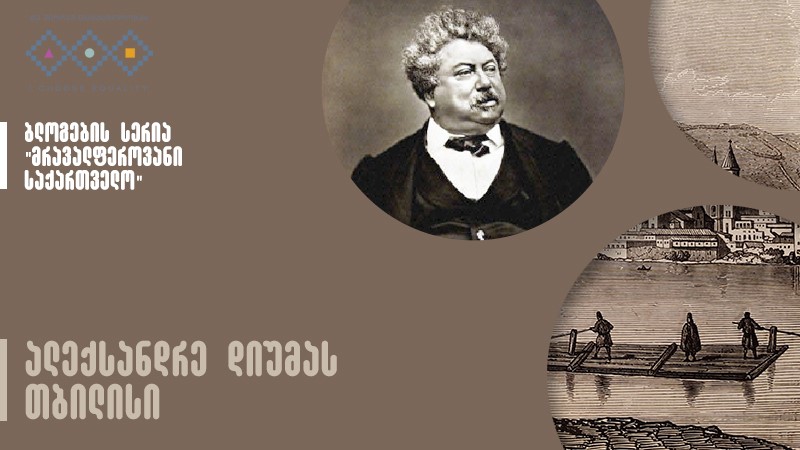Author: Sulkhan Saladze
In late 1858, Tsiskari magazine wrote: „From December 1 of this year, a renown French writer Aleksandre Dumas is visiting Tbilisi. He recently visited our editorial office. The writer, who is known all over the world, is currently travelling. Those who have read „The Count Monte Cristo“ certainly know the writer and those who haven’t, we’ll try to let you read it next year because we have the translation at the editorial office.“
It has been more than 160 years since Dumas’ travel in the Caucasus and publishing of this information in Tsiskari magazine. Nevertheless, interest toward Aleksandre Dumas work has not dwindled down. Dumas’ name is immediately associated with „Three Musketeers“, „Queen Margot“, „The Count Monte Cristo“ and numerous other works, however his „Adventures in Caucasia“, majority of which is about Georgia and is a fairy-tale-like description of his dangerous travels in diverse Georgia is equally interesting. With your permission, I would like to tell you about Tbilisi as seen by Aleksandre Dumas.
Colourfulness and diversity of Tbilisi is noticeable in the French writer’s records every step of the way. According to Dumas, under the instructions of French consul Baron Antoine Finot, he was accommodated in an outstanding house of a rich Georgian – Ivane Zubalashvili at the Theatre Square (current Freedom Square). However, the house was nothing compared to Tbilisi Opera Theatre. The building reminded him of Pompey’s Theatre, while the hall reminded him of a fairy castle. Dumas said that he had seen nothing like the hall of Tbilisi Theatre.
Tbilisi caravanserai and market hold a special place in Dumas’ records. According to the French writer, the building built by Gabriel Tamamshev, an Armenian from Tbilisi, which housed both a theatre and a caravanserai, was a gathering place for Georgians, as well as Turks, Armenians, Persians, Arabs, Indians, Chinese, Kalmukhi, Turkmen, Tatars, Circassians... They all wore their national clothing and had a special appearance. The caravanserai was close to a number of commercial streets in Old Tbilisi that had a special charm.
French Consul Barron Antoine Finot was usually quite busy in Tbilisi. In addition to representing interests of the French state, he was also very attentive to needs of the French living in Tbilisi (there was a French colony of 160 people residing in Tbilisi back then). Alexandre Dumas’ visit in Tbilisi however was a big deal and they needed something else to impress the writer, so the Baron took Dumas to Tbilisi Baths.
Eastern Tbilisi Baths made Dumas forget all about the beautiful European culture and Tbilisi Opera House. According to him, he was feeling so much pleasure that he could lift the entire Caucasus with open hands. When talking about Tbilisi Baths, he does not forget that Paris, the city of sweet feelings, does not have Persian baths at all. This is probably why during his month-long stay in Tbilisi, he visited the baths every other day.
The fact that Tbilisi was a diverse and different city is confirmed by a number of records by Dumas. Next to Opera Theatre and Tbilisi Baths, he tells equally interesting story about the city. It is also clear that he is very familiar with traveller records about Tbilisi from the second half of the 18th century and the beginning of the 19th century, especially letters of German orientalist Julius Klaproth and French traveller and trader, French Consul in Tbilisi in 1820-1824, Jacques Francois Gamba.
Before coming to Tbilisi, Alexandre Dumas thought that the city was similar to Baku and Nukhi, which he had already seen. However, as he humbly notes, he was wrong. Later the writer highlighted the importance of the Kura River and the city suburbs – Isani, Rike and German colony. Owing to the French colony, which mainly comprised of Parisian tailors and „fashionistas“, Tbilisi-dwellers and guests were able to go to the opera, just like in Europe.
When talking about Tbilisi, Dumas does not forget the rumours about plastic corsets. The main reason was artist Gregory Gagarin’s wife, who had brought a plastic corset from Paris. The entire city found out about it and everyone started talking about her beauty. Eventually, Gagarin’s wife wrote a letter to Madam Bonvallet, asking her to send a lot of corsets to Tbilisi.
On January 11, 1859, at 2:00 in the afternoon the writer left Tbilisi. Later Alexandre Dumas’ Adventures in Caucasia, a significant part of which was about Tbilisi, let readers rediscover the diverse city with its Eastern markets, caravanserais, baths, Western theatre and „fashionistas“.
The document has been prepared with the support of I Choose Equality campaign, implemented within the Council of Europe project “Fight against discrimination, hate crimes and hate speech in Georgia”. Opinions expressed in this document are the sole responsibility of the author and do not necessarily represent the official position of the Council of Europe.




